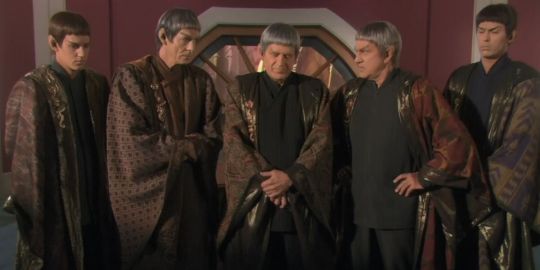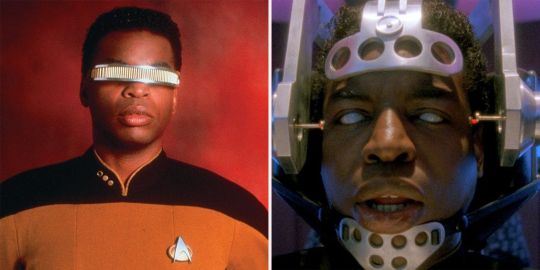#rata tafar tapan
Explore tagged Tumblr posts
Text
5 notes
·
View notes
Text


Matching pics of Spock and Saavik
Same vulcan scripts ( or at least very very similar) from Spock's TMP robes and Lady Saavik's Unification dress
The symbols are the vulcan characters for the words Rata, Tafar and Tapan, meaning " concept, mental discipline, cerebral process"
#saavik#s'chn t'gai saavik#spock#s'chn t'gai spock#star trek#star trek tos#star trek the motion picture#765874 unification#unification star trek
29 notes
·
View notes
Text

𝐶𝑜𝑛𝑐𝑒𝑝𝑡, 𝐷𝑖𝑠𝑐𝑖𝑝𝑙𝑖𝑛𝑒, 𝑃𝑟𝑜𝑐𝑒𝑠𝑠
#rata tafar tapan#𝐶𝑜𝑛𝑐𝑒𝑝𝑡#𝐷𝑖𝑠𝑐𝑖𝑝𝑙𝑖𝑛𝑒#𝑃𝑟𝑜𝑐𝑒𝑠𝑠#vulcan#vulcan script#spock#mr. spock#IDIC#infinite diversity in infinite combinations#star trek#the motion picture#logic
22 notes
·
View notes
Text
branches entwined form the tree
after finishing Star Trek: The Motion Picture and realizing i have no chill, i immediately restarted it with the commentary and have things to report
so the commentators discuss the vulcan script on those hella flattering robes spock wears upon his return to the enterprise

according to the costume designer, bob fletcher, these glyphs represent three words:
Rata ("concept"), Tafar ("discipline"), and Tapan ("process")

i’ve also seen the latter two clarified as referring to “mental discipline” and “cerebral process”. anyways, that’s pretty cool and definitely tracks as far as the uber intellectual vulcans are concerned
BUT bob fletcher took this a bit further in his notes. he elaborated that the conceptual meaning behind the combination of these words is:
“branches entwined form the tree”
and that’s beautiful. the whole movie is a commentary on the need to go beyond the “cold logic” of both the vulcans and v’ger. and here we have spock walking in with these poetic-ass robes which are honestly a slap in the face to his Kolinahr training.
for a line like that you need more than logic. you need well...a simple feeling.
#star trek: the motion picture#star trek i#star trek tos#spock#vulcans#vulcan calligraphy#vulcan script#vulcan language#rata tafar tapan#robert fletcher#bob fletcher#mina writes
360 notes
·
View notes
Text
Rata, Tafar, Tapan.

6 notes
·
View notes
Note
Hey! I’m relatively new to Star Trek and ever since I saw the motion picture I’ve been curious. Do you know what Spock’s robe says?
Na'Shaya! I'm assuming you mean this robe?

It says Rata Tafar Tapan, which translates to Concept, Discipline and Process. They're basic principles of Surakian philosophy and logic and it's quite common to see them on Vulcan robes, so keep your eyes peeled as you watch more Trek because you might spot them again!
LLAP!🖖
#star trek#spock#rata tafar tapan#vuhlkansu#vulcan language#Vulcan#vulcan language askbox#askbox#ask box#vulcan culture#the teachings of surak
112 notes
·
View notes
Text
This is amazing!
I finished the Star Trek Vulcan Tapestry quilt I was working on. It turned out lovely! I am very pleased.









425 notes
·
View notes
Photo





FREE SHIPPING on orders over $25 until Sept 24th!!
Hey, guys! Just a heads up that you can take advantage of Shapeways’ Free Shipping deal to grab some Vulcan Script Jewelry from my shop, if you’re interested!
You have a lot of options with just $25, too! You could grab the “Ashayam” Planetoid Pendant in classic stainless steel from the third photo above, or the “Rata Tafar Tapan” ring in raw brass.
Want the biggest variety for your money? Try mixing and matching in colorful plastics! All plastic rings are only $6! Pair them with any plastic Planetoid Pendant for just $10.
564 notes
·
View notes
Text
Star Trek TNG: 10 Hidden Details About The Costumes You Didn’t Notice
Some things about Star Trek: The Next Generation are unforgettable, including the customing. Women could wear the pantsuit too, and wearing red didn't mean a character was marked for death. The show tried some new designs that didn't work out. Remember the man-skirts, also known as "skants," from the earliest episodes? There's something Paramount wants you to forget. Well, it was the '90s. Never mind that Gene Roddenberry had some weird ideas when it came to fashion in the future.
RELATED: 5 Reasons The Next Generation Is The Best Star Trek Series (& 5 Why It Will Always Be The Original Series)
What about the small things that we didn't notice? The following is a list of the features or details of the Star Trek: TNG uniforms and costumes that you didn't notice because you were mesmerized by Beverly Crusher's shoulder pads, Riker's chest hair, or Deanna's Troi's deep V-neck pantsuit.
10 Colour Changes

The color palettes of TNG were different from Star Trek: The Original Series in a lot of ways, with muted maroon and teal making up most of the scheme as opposed to the much brighter primary hues of the old series. Even the reds were taken down a few notches to a much darker tone.
This was a major change but unless you were familiar with the original show, and even if you were, it might have slipped under the radar. These changes applied to virtually all the costumes, with bright colors reserved for specific characters. Deanna Troi wears purple on a regular basis while very few others ever do. The very first episode, where Q's clothing as a judge is a bright red set against black, is an example.
9 One Piece, Two Piece

The updated uniforms for our intrepid explorers went through a few changes, some obvious, others subtle. Did you notice how the one-piece jumpsuits from Season 1 and 2 changed to a two-piece uniform in Season 3? The actors were uncomfortable in the spandex jumpsuits. The costumes were deliberately fitted to be a size too small, intended to streamline the actor's body.
RELATED: Star Trek TNG: 10 Things You Didn't Know About The Theme Song And Intro
Even Patrick Stewart's chiropractor didn't like them. The costuming department made a more comfortable alternative, but the jumpsuits never went away. You'll still catch some extras wearing them in later seasons if you keep an eye out.
8 Officer Ranks and Insignias

You might have noticed those three gold buttons that officers have on their lapels. Someone with a naval or military background probably understands the important underlying meaning of this small detail. These buttons are actually called "pips."
In the case of Starfleet officers, the number of gold pips denoted their role in the hierarchy of leadership. For Cadets, they mimic the ranks used for Lieutenants in the United States Army. This was used for the first time in TNG and continued into Voyager and Deep Space 9.
7 Rata, Tafar, and Tapan

Vulcan attire seems plain at first, which goes along with their generally modest aesthetic, but you'll notice there's more to the patterns if you take a closer look. The use of certain sacred letters on Vulcan clothing started in earnest with the Star Trek films and continued into TNG.
RELATED: Star Trek: Picard Is A Hybrid Of Discovery & Next Generation
The meaning of these symbols is still fairly secretive, but we know that they are the Vulcan words Rata, Tafar and Tapan. They represent concept, mental discipline, and the cerebral process, and are written in vertical lines on robes, shrouds and other types of Vulcan clothing. Malat, the word that means nature, is sometimes included.
6 Gemstones and Triangles

Certain symbols and shapes recur in ritual clothing from Vulcan well beyond what we know about the three main sacred symbols. These include triangles, gemstones, and unique attire never seen outside of sacred Vulcan rituals.
At the end of Star Trek: The Search for Spock, most of the robes worn in this scene are mostly either unmarked or decorated with an equilateral triangle, with some subtle exceptions. In TNG, Vulcan clothing often includes large gemstones, sometimes with the sacred letters that represent any or all of the letters for Malat, Rata, Tafar, and Tapan.
5 Fictional Boobage

Oh, so we're calling ourselves "woke" because men can wear skirts and women can be in charge of security? Then what's with all those padded bras, complete with seamless cups, that are required in every woman's costume?
RELATED: Star Trek Voyager: 5 Times Janeway Was the Best Captain (And 5 Times She Was the Worst)
Sorry to break your hearts fellas, especially you, Riker, but almost all of that cleavage was fake. This is nothing new, the practice had been going on since The Original Series. That is, until Captain Janeway showed up. Local Hollywood legend has it that Kate Mulgrew famously ripped her padded bra out of her uniform and threw it on the producer's desk, flat-out refusing to wear it. You go, girl!
4 Klingon Fashion

As their alliances changed, so did their clothing. The details of Klingon attire shifted dramatically between The Original Series and The Next Generation. That clunky gold Klingon Baldric was so overwhelming it drew your eye and obscured any other details.
Apparently, even actor Michael Dorn wasn't fond of the original design, as a Klingon might want something more rustic, and the costuming department agreed with him. By Season 2, in a change you probably missed, the Baldric was made out of a series of bicycle chains to make it look more Klingon and less Federation.
3 Smoking Accessories

This is more about the accessories for costumes, which can be as important as the costumes themselves. In a move that seems to contradict how modern and politically correct TNG was trying to be, take note of how often we see someone smoking.
RELATED: Star Trek: The 10 Deadliest Villains The Next Generation Crew Ever Faced
Whoopi Goldberg's recurring character, Guinan, was often seen smoking a cigarette. Data as Sherlock Holmes, or sometimes not as Sherlock Holmes, smoked the iconic pipe. Once you notice this, it's impossible to forget, and you'll be surprised at how often it happens.
2 The Combadges

It's more than a convenient way for Starfleet to find you. The badge each character wears has a specific design and meaning, and it's an essential part of your uniform. You know that stuff just got real when someone removed a combadge, making it a convenient plot device on top of everything else.
Somewhere between TOS and later episodes of TNG, there was a small design change. The combadges of later Star Trek shows, like TNG and Deep Space 9, have a more pronounced Starfleet "V" shape with a circle in the background, as opposed to the square design used on Star Trek: Voyager and later episodes of Deep Space 9.
1 Geordi's Visor

When Geordi Laforge is first examined by Doctor Crusher, they are discussing remedies for the constant pain he's in because of his visor. You had no idea since LaVaar Burton is a talented actor, but he really was in a lot of pain because of that thing.
It was an essential part of his costume, too, so there were few alternatives. When it was replaced by a heavier one that required actual screws, things got even worse. We know that actors are often coached to use discomfort or pain to their advantage, but this is too on the nose, or maybe we should say, on the head.
NEXT: Star Trek: The Essential Next Generation Episodes To Watch Before Picard
source https://screenrant.com/star-trek-tng-hidden-details-costumes/
0 notes
Photo


rata tafar tapan sv2m
14 notes
·
View notes
Photo

Rata Tafar Tapan
Concept Discipline Process
#rata tafar tapan#surakian philosophy#teachings of surak#sand#sand calligraphy#sand art#Vulcan#Vulcan language#Vulcan calligraphy#vuhlkansu#vuhlkansu calligraphy#gotavlu-zukitaun#Tik-Nahp
28 notes
·
View notes
Photo

Sarek’s meditation robe from Star Trek: The Next Generation
Source
29 notes
·
View notes
Text
It is logical to serve looks: traditional Vulcan clothing.
Traditional Vulcan clothing normally consists of several layers of robes in contrasting earth and jewel tones. Sashes are often worn with robes, but are not commonly worn with shorter shirts. The materials used are mostly natural, like tugno't or sha'amii wool. Dr'thelek silk, which is not produced or sold outside Vulcan, is traditional for formal gear; however, younger Vulcans favour lighter materials, like Tholian silk. Clothing is cut pretty much the same for men and women, and gender is not typically indicated by style.
Did you know there are actually many words in the Vulcan language to designate specific styles of robes? I have compiled a vocabulary list with some traditional Vulcan clothing items that don't quite translate with the same degree of precision into English:
ROBES AND SASHES
Beyip: a light robe, often worn under other robes, or over a ne’ahn. The front wraps left over right and is attached on the right side with knotted buttons or with electrostatic seams. Worn as casual wear for business or other activities. May be worn with a casual sash or a mos’opelal if necessary for warmth.
Mos’opelal: A “soft” or light version of the more formal opelal, worn on less-formal occasions.
Si’pelal: an outer, sleeved robe, usually of heavier and elegant fabric, worn over the beyip and under the opelal in more formal ocassions, and always worn with a sash.
Opelal: a heavy “honorable robe” (formal robe), often with broad shoulders, loose sleeves, and a wide hood, worn open at the front to show a contrasting si’pelal. Often, “Rata Tafar Tapan” is embroidered on the right lapel of this garment, specially if the wearer has completed Kolinahr.
Osan-wun: Formal sash, typically consisting of two or three bands, each a bit wider than a typical sash. The ends of a sash can normally be worn long, sometimes nearly to the ground, but in formal occassions that call for the use of an osan-wun, stylized knots are used to keep the ends closed and flat against the sash.

Pel-ahn: A light ankle-length garment, typically with long sleeves and often worn as casual everyday dress. It also crosses left over right and fastens at the right shoulder. Typically not worn with a sash. It is looser and more utilitarian than a beyip. A version that extends only to the hips and is worn with trousers also exists and is called a sav-ahn.

Pel-pen: Medium-length robe, wrapped left to right and fastened on the right side with several buttons. Typically knee-length with wide half- or 3/4-sleeves and belted about the waist with a sash or belt. Can be worn with trousers or not.
M’ai-wem: a long-sleeved, floor-length dress, often worn with a light opelal. Similar to a pel-ahn, but more close-fitting.
Pi’to-sai: Small cloak. A light cross between a robe and a cloak, typically worn over a beyip, pel-ahn or m’ai-wem.

Salan-sai: A “cloak of breezes.” A sheer, draped, sleeveless garment, open or lightly fastened at the front, worn casually around the house on hotter days. Often brightly-colored and patterned. More formal versions are normally white and worn for ritual functions by lesser celebrants and called y’osalan-sai.

To-pen: A short cape, normally with a hood and wide lapels which extend below the lower edge in front.

To-sai: A cloak, typically calf- or floor-length, with a hood and openings at the sides to allow the arms to pass through. Similar to an opeleal, but more casual and seldom made of costly fabric.

Tipan-dosh: A ritual vestment, consisting of a strip of heavy fabric, shoulder-width or slightly broader, with a hole in the middle for the head. Some come to a point. A tipan-dosh is worn over the y’osi’pelal.

Ak’shem-ai: a traditional bodysuit. Can be worn by itself or under a y’osalan-sai.

Tipan-zhvi: A ritual vestment rather like a rationale, worn across the shoulders and draped down the front and back. Often with cut-outs to reveal the y’osi’pelal (ritual si’pelal) beneath.

To-pal-el: A light jacket of hip- or thigh-length, open at the front and not typically worn closed. Usually has a high collar. A generally utilitarian piece of clothing worn for everyday use. A similar garnment is the pel-pen-zh’e, which does fasten (usually in the middle), is often sleeveless, and it's cut on the sides to show the trousers worn beneath.
Abru’sav-el: a shirt which is drawn on over the head and has no seams or fastenings. Typically has long sleeves, but versions with short sleeves do exist.
Pel-el: A shirt that wraps across the front, left over right, like a robe, and typically covers the tops of the thighs. It is worn with trousers and occassionally a mos-opelal and/or a light sash as casual “business-wear.”

Pi’mal-kan: A child’s short pants, similar to briefs. Sometimes worn with a pi’san (child’s sash), worn as a baldric across the chest, and carrying family and school markings (shasu’buhk).

ACCESSORIES
Kuvor-talk: a simple closed cap that covers the back of the head, with cheek pieces cut high to expose and highlight the ears.
Ozhup’ai: ceremonial crown worn by officials for highly-formal events
Patam-puna-ti: a type of shawl covering the head and shoulders, typically worn close to the hair.

Patam-wun: a cloth wrapped around the forehead, typically bound at the back with an elaborate knot.
Patem-sai: a type of traditional hat worn throughout vulcan society, though its use is waning outside of ceremonial occasions.

Tark-oyel: “Star coronet”. Worn at many ceremonial events, the the two horn-like shapes represent the red and the white stars visible in the Vulcan sky.

Y’svit azh’wein: a ritual mask that covers the nose and mouth, used only during ceremonies by certain celebrants, such as honor guards. It is derived from an ancient desert mask designed to protect the nose and mouth from dust.

Zhup’ai: a type of hat worn for formal events or as a craftsman’s traditional clothing.

Ut’talu: Interestingly, Vulcan has two words for “necklace”. An ut'talu is solid and torque-like, as opposed to a vik'talu, which is a pendant hanging on a chain or cord. By the way, the most widely used stone in Vulcan jewelry is rubinite, as it's very common in Vulcan.

UNDERWEAR
Ash’ai-kuv: a kind of garter typically worn above the knee, usually with some form of ritual symbol or markings. Worn under the clothing by religiously-minded Vulcans.
Ash-wu: a high sock or stocking that typically covers up to the upper thigh. These are worn almost entirely for formal and ceremonial occassions.
Ne’ahn: under robe, often with 3/4 sleeves, white or pale-toned and ankle-length. Often has a high collar which can be seen above the collar of a beyip or pel-ahn.
Ne’ak’shem: a type of short bodysuit or leotard used as underwear. It is elastic, close-fitting and has no fastenings. Some Vulcans prefer it instead of Terran-style underwear.
Pi’toh: a type of loincloth consisting of rectangular panels and a cord to tie it in place. It has currently fallen out of fashion and is only worn for certain ceremonial purposes or by very traditional Vulcans, but it appears often in depictions of pre-Surakian times.
Sources: VLD, VLRP, Hidden Universe Travel Guides: Star Trek: Vulcan, Christies, Purple Sloth, ENT, TAS, ST: TMP, ST: Beyond, ST: SFS, ST: FC, STO.
#long post#text post#star trek#vulcan culture#vulcan artifact#vulcan clothing#vulcan robes#vulcan fashion#clothing#clothes#vulcan clothes#robes#vulcan vocabulary#vuhlkansu#vuhlkansu vocabulary
938 notes
·
View notes